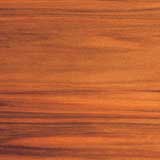|
For years American Gum has borne the stigma of being unstable and it is true that this freshly sawn lumber will warp more than most species. Technical studies of wood structure and developments in staking, seasoning and kiln drying methods have overcome this tendency to a point where it will retain its dimensional stability about as well as any other wood today.
American Gum is generally divided into two classifications for commercial purposes. Red Gum is obtained chiefly from the heartwood of old mature trees in somewhat limited quantities. Sap Gum, obtained from the sapwood, and is used in greater quantity for a larger range of products because it is available in young as well as old trees. The color of Red Gum ranges from a light to deep reddish brown and much of the lumber contains irregular dark streaks formed by natural deposits of coloring matter in the wood which closely resemble those in Circassian Walnut. Sap Gum retains the basic red color in a subdued form, from a delicate pink to a pinkish white. It has some of the figure characteristics of Red Gum but not so pronounced. The mechanical properties of Red Gum and Sap Gum are substantially the same. Gum, generally speaking, has a peculiar interlocking grain which makes it strong and stiff and offers high resistance to splitting. It is one of the softer hardwoods of medium weight and its compact grain takes a beautiful finish. Since it is not resinous, it is especially adaptable for painting and enameled woodwork. Gum has a soft but firm texture which responds well to cutting tools. It is an excellent turning and carving and planning wood. Red Gum is one of the leading furniture and cabinet woods of the country for the better grades of product. Sap Gum is also much used on medium and lower price grades for exteriors and for interior constructions in the better grades. Gum has long been used with Walnut and Mahogany, which it so closely duplicates in appearance. Now, the beautiful natural figure is gradually coming into prominence in its own right. Gum is the leading furniture and cabinet veneer for decorative plywood. Gum is used for side, back and end panels, drawer bottoms, dust bottoms, mirror backs and often forms the core and crossbanding for plywood faced with fancy veneers. As paneling, doors and interior trim, Gum has many features which few other woods can match. Since its pattern is uniform throughout the log, Gum can be used as paneling for the wall treatment of a room in which the predominating figure is continuous to duplicate itself around the entire wall. Gum is a favored wood for cabinets, radio, television and home entertainment centers because it is resonant, mellow and can be finished to blend with either cabinet wood or plastic surfaces. Other common applications are found in store fixtures, automobile and wagon bodies, agricultural implements, structural parts of organs and pianos, refrigerators, toys, trunks, handles, novelties and miscellaneous woodenware. In the lower grades, Gum is much used for boxes and crates and is a most important wood for slack cooperage. It is also used for cheap flooring, railroad ties, cigar boxes, and more recently for chemical wood pulps. |

